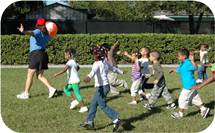Physical Activity in Schools: How Does Your Child’s School Compare?

Did you know that to meet the national guidelines children and adolescents need to be physically active at least 60 minutes a day? With childhood obesity at an all time high and students spending a large portion of their day in school, the American Alliance for Health, Physical Education, Recreation and Dance (AAHPERD) recently surveyed physical educators and other school officials across the country to find out how much physical activity children were getting in school. After gathering responses from more than 1,200 people, AAHPERD found that less than one sixth of schools (16% of elementary, 13% of middle and a mere 6% of high schools) currently provide opportunities for children to be physically active before, during, and after school.
Why is Physical Activity So Important?
- Sharpen Mental Focus: Research shows that physical activity can positively affect blood flow and oxygen to the brain (improving mental clarity, learning and memory) and improve attention and information-processing skills
- Build Strong Bones: Physical activity also helps build strong bones and muscles
- Maintain Health: Regular physical activity helps decrease likelihood of obesity and disease, promotes positive mental health, and reduces anxiety and depression
Let’s Get Moving
The goal of AAHPERD’s Let’s Move in School initiative is to ensure that every school provides a Comprehensive School Physical Activity Program (CSPAP) and also provides opportunities for students to be physically active before, during and after school. AAHPERD is urging parents, principals, superintendents, school board members and physical education teachers to play a role in helping our youth become active and in making quality physical education and activity a reality in local schools.
Quick Facts
Physical Education
- Physical education is most commonly provided in elementary schools (of the 90% of schools that responded)
- Only 44% of high schools provide physical education
- In 92% of schools, classes are taught by a state certified physical education teacher
Physical Activity During School
- More than 80% of schools provide recess, an example of physical activity during the day
- Seventy-six percent provide recess every day and 65% of the schools allow 15-29 minutes each time
- In nearly two-thirds of elementary schools, physical activities are integrated in the classroom either between or during lessons or at the start of the day
Physical Activity Before and After School
- Walk/bike to school programs are very common in elementary schools (22%) versus middle (16%) and high schools (11%)
- Intramural sports are offered in almost 63% of schools
- High schools provide the most opportunity for interscholastic sports with 89% compared to only 14% in elementary schools
Staff and Family and Community Involvement
- Forty-two percent of schools or school districts offer its employees physical activity classes, but less than half of staff members actually participate
- Fifty-five percent of schools conducted or planned to conduct events where families would be invited to participate
- Nearly one-third of schools asked students what they thought of their current physical education and physical activity program
- Outdoor facilities, gyms, and fitness centers are commonly made available for families to use, but 50% of schools reported they don’t have a fitness center
Take Action
To make certain that your child is well-equipped for a lifetime of physical activity, talk to their physical education teacher and principal about increasing physical activity at school. Share the Let’s Move in School free online toolkit with your PTO/PTA to help assess your student’s current physical education program and discuss how to make positive changes.
Paula Keyes Kun is the director of communications at NASPE/AAHPERD, a leading nonprofit education organization representing close to 20,000 educators. She manages media relations, partnerships, communications, publications and periodicals.

